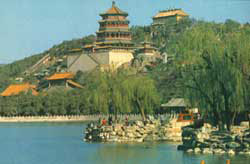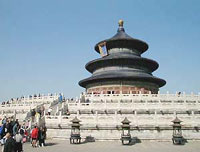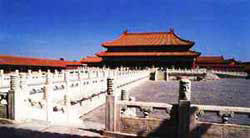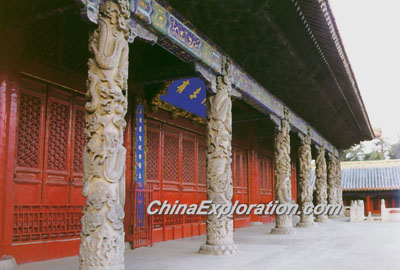search for a Trip
Introduction of Beijing

As the capital of China with, Beijing city is China’s political, cultural center as well as a transport and international exchange hub. It has 3000 years of history. This ancient, young, solemn, and yet charming famous city of culture draws millions of domestic and overseas tourists all the year round.
The city encompasses 17020 square kilometers with a population currently 14 million. It is one of the four centrally administered cities in the county, the other three being Chongqing, shanghai and Tianjin. Beijing has a continental climate of temperate zone with four seasons distinctly divide. Autumn is characterized by clear sky and crisp air as well as beautiful scenery, so the city is a magnet for visitors both home and abroad.
Main attractions in Beijing
The Forbidden City:
Forbidden City, also called Palace Museum or Gugong in Chinese, is the grandest integral Palace complex still remaining in China. It used to be the imperial palace of the Ming and the Qing, the last two dynasties of China. It encompass 72 hectares 720000 with more than 90 courtyards of various sizes. Actually the Forbidden City is a super giant courtyard. It is rectangular in shape 961 meters long from north to south and 753 meters wide from east to west. There is a 3428-meter-lonf and 10-meter-high wall, encircled by a 3800-meter-long and 52-meter wide moat. Forbidden City is divided into two parts: The outer court was where the emperor exercised his supreme power over the nation. The northern section or the inner court was where he lived with his royal family. The entire architectural layout was designed to bring out the supreme authority of the emperor and the hierarchy of the feudal society. All the principal palaces lie on the axis of the old city of Beijing and groups of buildings on both sides were laid out to achieve the symmetrical effect of perfect unity.
The summer palace:
The Summer Palace lies about 20 kilometers northwest of Beijing. It consists of Longevity Hill(59 meters high) and Kunming Lake encompassing 290 hectares. Longevity Hill is an extension of the Jade Spring Hill Lying to its west. Kunming lake used to be its source from Miyun Reservoir. This present Summer Palace covers an area of 294 hectares, of which three quarters is water. The garden can be divided into three parts, administration, residence and scenery browsing area. The administration area, taking Halls of Benevolence and Longevity as its principal part, is the place where Cixi dealt with state affairs and received officials. Residence area mainly consists of Hall of Jade Billows, Garden of Virtue and Harmony, and Hall of Joyful Longevity. The Kunming Lake and Longevity Hill then serve as the scenery browsing area.
The Temple of Heaven:
 The temple of Heaven is situated in the southern part of Beijing city. It was built in 1420,and reconstructed in 1530,encompassing 273 hectares. The perimeter of Temple of heaven is 6369 meters long and 6 meters high. The Temple was the place where the emperors of the Ming(1368-1644) and Qing (1644-1911)dynasties worshipped heaven and prayed for good harvests. They came here twice a year ,on the 15th day of the 1st lunar month and on winter solstice. At first, both heaven and earth were worshipped here. After 1530 when the Temple of Earth was built in the northern suburbs, only heaven was worshiped in this temple.
The temple of Heaven is situated in the southern part of Beijing city. It was built in 1420,and reconstructed in 1530,encompassing 273 hectares. The perimeter of Temple of heaven is 6369 meters long and 6 meters high. The Temple was the place where the emperors of the Ming(1368-1644) and Qing (1644-1911)dynasties worshipped heaven and prayed for good harvests. They came here twice a year ,on the 15th day of the 1st lunar month and on winter solstice. At first, both heaven and earth were worshipped here. After 1530 when the Temple of Earth was built in the northern suburbs, only heaven was worshiped in this temple.
The Great wall:
The Great wall, symbolizing China’s ancient civilization, is one of the world’s most renowned projects. It is a distance of 75 kilometers northwest of Beijing. Its highest point at Badaling is some 800 meters above sea level. A well-known popular saying goes: ‘He who hasn’t been to Great Wall is not a true man’. Located in Yan Qing northwest of Beijing. It was built in the beginning of Ming Dynasty and was a special section of the Ming Great Wall. As an important Pass, Ba Da Ling Great Wall means getting to all the directions in English. The total length is 4500 meters. Many beacon towers, watch towers add more magnificence to the Great Wall.
The Ming Tombs:
 Ming Tombs was a very special place to bury the Emperors of Ming Dynasty. Some 50 kilometers northwest of the capital, the Ming Tombs are generally combined with a visit to the Great Wall. Ming Tombs consist of mausoleums of 13 Ming emperors. So it is also called Thirteen Ming Tombs, located on the southern side of the Tianshou Mountain in Changping County, about 50 Kilometers north of Beijing. Among the 13 mausoleums, the most famous ones are the Changling and Dingling. Construction of the first tomb, Changling, was started in 1409 and completed in 1427. The whole construction of the 13 Ming Tombs took more than 200years. A Sacred Way stretches 7 Kilometers from south to north through the center of the site.
Ming Tombs was a very special place to bury the Emperors of Ming Dynasty. Some 50 kilometers northwest of the capital, the Ming Tombs are generally combined with a visit to the Great Wall. Ming Tombs consist of mausoleums of 13 Ming emperors. So it is also called Thirteen Ming Tombs, located on the southern side of the Tianshou Mountain in Changping County, about 50 Kilometers north of Beijing. Among the 13 mausoleums, the most famous ones are the Changling and Dingling. Construction of the first tomb, Changling, was started in 1409 and completed in 1427. The whole construction of the 13 Ming Tombs took more than 200years. A Sacred Way stretches 7 Kilometers from south to north through the center of the site.
Yonghegong Lamasery:
Yonghegong Lamasery or Yonghe Gong, is a famous lamasery located in the northeastern part of the old city of Beijing. It was a palatial residence built in 1694 by Qing Emperor Kangxi for his fourth son, Prince Yongzheng who later succeeded to the throne. This magnificent temple consists of five main buildings lying on the north-south axis, with annex halls standing on both sides. The temple is listed by the Chinese Government as one of the important historical monuments under special preservation.
Confucius Temple :
 The Confucius Temple, also called Kong Miao temple, is now the Capital Museum and houses a display on the culture and history of Beijing. Confucianius was born in Qufu, China. The temple in Beijing is among the largest Confucian temples outside Qufu. Communism views Confucism in a dim light; Confucian philosophy was the worldview of Chinese feudalism.
The Confucius Temple, also called Kong Miao temple, is now the Capital Museum and houses a display on the culture and history of Beijing. Confucianius was born in Qufu, China. The temple in Beijing is among the largest Confucian temples outside Qufu. Communism views Confucism in a dim light; Confucian philosophy was the worldview of Chinese feudalism.
The Temple's main hall houses musical instruments that were important for Confucian ceremonies. The temple also contains 198 stone tables inscribed with the names of those individuals who passed the test to become a Mandarin during the Yuan, Ming, and Qing dynasties: 51,624 names.
The Imperial Academy sits next to the Temple. The Academy was founded in 1306. The Academy taught language and martial arts. In 1462 it had 13,000 students. Today the Academy is the Capital Library, which houses collections on the social sciences and on local history.

Fragrant Hills Park:
Situated in the east part of western hills, 28 kilometers (17 miles) northwest of the Beijing City, Fragrant Hills Park is a large park of hills and forest covering 160 hectares (395.4 acres). Both its natural sceneries and cultural relics are abundant. Xianglu Peak (Incense Burner Peak), 557 meters (1827.4 feet) high, is its highest peak.
Hu tong:
Hutong is a kind of typical ancient city alley in Beijing. Many of them were built during the Yuan (1206-1341), Ming (1368-1628) and Qing (1644-1908) dynasties surrounding the Forbidden City.
Click to see Beijing tours
China Attractions Guide
- Anhui Attractions
- Beijing Attractions
- Chongqing Attractions
- Fujian Attractions
- Gansu Attractions
- Guangdong Attractions
- Guangxi Attractions
- Guizhou Attractions
- Hainan Attractions
- Henan Attractions
- Hongkong Attractions
- Hubei Attractions
- Hunan Attractions
- Inner Mongolia Attractions
- Jiangsu Attractions
- Jiangxi Attractions
- Manchuria Attractions
- Ningxia Attractions
- Qinghai Attractions
- Shaanxi Attractions


